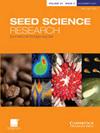Quantifying seed germination based on thermal models to predict global climate change impacts on Cerrado species
IF 2.1
3区 生物学
Q2 PLANT SCIENCES
引用次数: 0
Abstract
Abstract Seed germination is regulated by temperature and can thus be quantified by thermal models, which can predict germination occurrence in biomes and plant survival under possible climate change scenarios. The objective of this study was to quantify germination based on thermal time and survival risk of 14 species in the Brazilian Cerrado in scenarios of future climate change. Seeds were collected in the warmer regions of the Cerrado, central Brazil, placed in incubators to germinate at constant temperatures of 10–50°C and evaluated every hour or day. Germination rate (R50), time for germination of 50% of the seeds (T50) and dent-like function were used to determine cardinal temperatures. Thermal time parameters were estimated using the Weibull model. Seed germination forecasts were made based on the International Panel on Climatic Change (IPCC) scenarios of global temperature increase. Base temperatures (Tb) ranged from 3.5 to 16.5°C, maximum temperatures (Tmax) from 35 to 50°C and optimum temperatures (To) from 30 to 35°C. Estimated thermal time varied from 484°C h to 400°C d at sub-optimal temperatures and 108°C h at 126°C d at supra-optimal temperatures. Species more distributed showed a higher thermal range of germination and are less susceptible to extinction in temperature increase scenarios. The results of this study suggest that seeds that are non-dormant after dispersal may be the most vulnerable in the future. In this context, our predictions contribute to understand how the survival of trees and shrubs will be affected in the Cerrado in the future.基于热模型量化种子发芽以预测全球气候变化对塞拉多物种的影响
摘要种子发芽受温度调节,因此可以通过热模型进行量化,热模型可以预测生物群落中发芽的发生和植物在可能的气候变化情况下的存活。本研究的目的是根据巴西塞拉多14个物种在未来气候变化情况下的热时间和生存风险来量化发芽情况。在巴西中部的塞拉多温暖地区收集种子,将其放置在恒温箱中,在10–50°C的恒定温度下发芽,并每小时或每天进行一次评估。发芽率(R50)、50%种子的发芽时间(T50)和凹痕样函数用于测定基本温度。使用威布尔模型估计热时间参数。种子发芽预测是根据国际气候变化专门委员会(IPCC)关于全球气温上升的设想进行的。基本温度(Tb)范围为3.5至16.5°C,最高温度(Tmax)范围为35至50°C,最佳温度(to)范围为30至35°C。在次优温度下,估计的热时间从484°C h到400°C d不等,在超优温度下从126°C d到108°C h不等。分布更广的物种表现出更高的发芽热范围,在温度升高的情况下不太容易灭绝。这项研究的结果表明,扩散后未休眠的种子在未来可能是最脆弱的。在这种情况下,我们的预测有助于了解塞拉多未来树木和灌木的生存将如何受到影响。
本文章由计算机程序翻译,如有差异,请以英文原文为准。
求助全文
约1分钟内获得全文
求助全文
来源期刊

Seed Science Research
生物-植物科学
CiteScore
3.60
自引率
4.80%
发文量
23
审稿时长
>12 weeks
期刊介绍:
Seed Science Research, the official journal of the International Society for Seed Science, is a leading international journal featuring high-quality original papers and review articles on the fundamental aspects of seed science, reviewed by internationally distinguished editors. The emphasis is on the physiology, biochemistry, molecular biology and ecology of seeds.
 求助内容:
求助内容: 应助结果提醒方式:
应助结果提醒方式:


